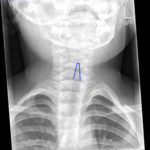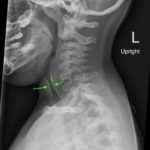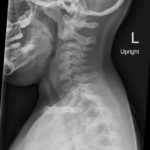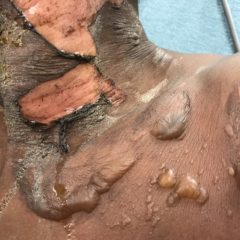Croup
History of present illness:
A 4-year-old male presented with difficulty breathing at 2 am, gasping for air, without changes of color of his lips or face. Mother reported a dry intermittent cough and rhinorrhea for the past day without fever or vomiting. He had no past medical problems and his vaccinations were up-to-date.
Significant findings:
The anteroposterior X-ray reveals the classic steeple sign (blue outline) indicative of subglottic edema leading to tracheal narrowing, consistent with croup. The lateral x-ray shows narrowing of the subglottic region (green outline and arrows).
Discussion:
Laryngotracheobronchitis, croup, is a common respiratory infection causing inflammation of the larynx and trachea and affects 3% of children six months to three years of age.1 This swelling leads to the hallmark barking cough and inspiratory stridor frequently heard in young children with croup.2 While croup is a clinical diagnosis, radiographs are helpful and can assist in excluding other causes. The classic steeple sign associated with croup represents subglottic edema; it can be seen in other upper airway inflammatory conditions, and has been shown to be present in only 50% of croup cases, reinforcing that clinical acumen is very important in making this diagnosis.3
The most important aspect of laryngotracheobronchitis is protecting the airway. Treatment includes mist therapy, corticosteroids, and racemic epinephrine. Racemic epinephrine is recommended in patients with moderate to severe croup.1 In a meta-analysis study of randomized controlled trials, it was found that glucocorticoids, dexamethasone or budesonide, improved the Westley croup score at 6 hours and led to fewer interventions and hospitalization time.4 The Westley croup score is a primary research tool that characterizes the severity and progression of croup based on five criteria including chest wall retractions, stridor, cyanosis, level of consciousness, and air entry level.
This patient’s symptoms improved after he received one dose of oral steroids in the emergency department. He was discharged home with strict return precautions including stridor and worsening shortness of breath and told to follow up with primary care doctor in two days.
Topics:
Croup, laryngotracheobronchitis, steeple sign, X-ray.
References:
- Smith D, McDermott A, Sullivan J. Croup: diagnosis and management. Am Fam Physician. 2018;97(9):575-580.
- Lee DR, Lee CH, Won YK, Suh DI, Roh EJ, Lee MH, et al. Clinical characteristics of children and adolescents with croup and epiglottitis who visited 146 emergency departments in Korea. Korean J Pediatr.2015;58(10):380-385. doi: 10.3345/kjp.2015.58.10.380
- Malhotra A, Krilov Lr. Viral Croup. Pediatr Rev.2001;22(1):5-12.
- Ausejo M, Saenz A, Pham B, Kellner JD, Johnson DW, Moher D, et al. The effectiveness of glucocorticoids in treating croup: meta-analysis. Med. J.1999;319(7210):595-600. doi: 10.1136/bmj.319.7210.595






